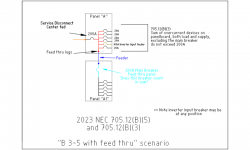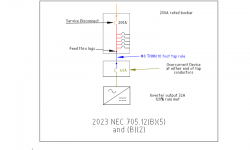prof.dmiranda
Member
- Location
- Puerto Rico
- Occupation
- Design Technician
I'm started working at a PV design company. One of our clients instructed us to always include a main breaker in the sub-panel if said sub-panel, is fed through lugs and is not protected, whenever we design with a backfeed breaker inside the 120% rule. The reasoning is that the new MCB in the sub-panel will "break" the bus bar from the main panel, thus making the end of the bus bar the bottom of the main panel. If the new 200A breaker is not there, then the end of the bus bar would be at the bottom of the sub-panel. They want to be inside the NEC 705.12 (3)(2) Where two sources, one a primary power source and the other another power source, are located at opposite ends of a busbar that contains loads...I apologize if the terms I used are not correct. I hope I explained myself in a clear manner.




